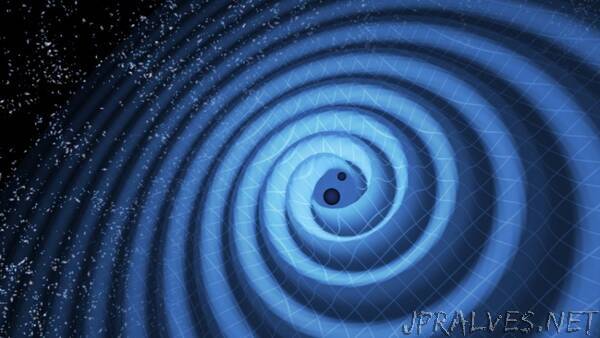
“While light can’t escape the monstrous gravity of a black hole, that hasn’t kept researchers on a team that includes UO scientists from taking a big step forward in the effort to reveal their secrets.
UO researchers are a key part of LIGO, an international effort to find and understand gravitational waves. Last week, the LIGO team released the largest catalog of gravitational wave data yet, detailing 35 new collisions from their latest data collection run. Fourteen UO researchers, including nine students, contributed to the new release.
“We’re getting better and better,” said Robert Schofield, a research scientist who began working with the UO’s LIGO group in the late 1990s. “This data run is more sensitive than the one before it, and we could see black holes colliding further into space.”
Millions of light years away, violent collisions between black holes and neutron stars send ripples through spacetime. These ripples, called gravitational waves, eventually reach Earth as infinitesimally faint signals. And LIGO’s super-sensitive detectors can pick them up.
Scientists at LIGO, for Laser Interferometer Gravitational-Wave Observatory, spotted the first gravitational waves in 2015, to great excitement that was followed by a Nobel Prize in physics in 2017. Today, thanks to improvements in the technology, detection events are becoming more and more common.
With the LIGO instruments, “we can look at the universe now in a way that other telescopes can’t,” said UO physicist Ray Frey.
“This last observing run included some events that were exceptional on their own, like the first detection of binaries with one neutron star and one black hole,” said UO physicist Ben Farr. “But now, with almost 100 events, what’s just as exciting is the bigger picture that’s coming into focus.”
There’s enough data to start analyzing it in more complex ways, to draw bigger conclusions about the nature of the universe and how black holes are formed.
“It’s important to know what’s out there in the universe, so that when we detect something new, we can compare it to what we know,” said Bruce Edelman, a graduate student in Farr’s lab.
As part of this new data release, Edelman helped lead an analysis of all the black hole and neutron star collisions detected so far.
From a gravitational wave signal, scientists can estimate the masses of the objects that collided and how far they are from Earth. They can also make inferences about what else might have been happening in the vicinity, whether the two merging objects were the only things around, for example, or whether there were other stars nearby that might have been influencing the process. And they can compare those things on a population level, looking for patterns and trends.
The LIGO team has done similar calculations in the past, but there were so few data points that they had to make simplifications that obscured details.
“We’re detecting so many more objects now, so we can get more sophisticated,” Edelman said.
Behind the scenes, there’s another facet to LIGO’s success: A team of scientists dedicated to improving and monitoring LIGO’s instruments, a pair of detectors located in Hanford, Washington, and Livingston, Louisiana. And UO researchers are integral there, too.
Gravitational waves are so faint by the time they reach Earth that they can be drowned out by closer-to-home disturbances most of us wouldn’t even notice. For example, the early LIGO detectors were so sensitive that water going over a dam 30 kilometers away could throw off the data, said Schofield, who co-leads the environmental monitoring at the Hanford detector. He and his colleagues have placed a bevy of sensors around the detectors, which keep track of external disruptions like rumbling traffic or crackling lightning.
Every time there’s a gravitational wave detection, the team must that check that it’s real. Now that the detections are becoming so much more frequent, they’re working to automate the process. Philippe Nguyen, a graduate student in Frey’s lab, is helping lead the push for automation. He wrote and tested computer code that checks the data against other events happening at the same time, to estimate the likelihood that any detected signal is influenced by something happening on Earth.
“We use real-world events to see whether my predictions actually line up what we see with the detector,” Nguyen said, and then adjust the computer program as necessary.
While LIGO is hitting its stride, the team is still working to make it even better. “Right now, I’m working all the time, fixing and improving things so we’ll do better next run,” Schofield said.
The next data collection run is scheduled to begin in December 2022.
“It’s awesome being part of this really motivated group, and it’s awesome seeing so many people so fascinated by it,” said Nguyen. “You really feel like you’re a part of something bigger.””
